


EDWARD JENNER 1749 - 1823 (G2, G3a, G3b,
G3c, G4)
xxxxxIn 1796 the English physician Edward Jenner proved that an
inoculation of cowpox provided an immunity from smallpox. He
discovered this after noticing that milkmaids who had caught cowpox
never contracted smallpox - then a serious killer-disease.
Two years later he set out his findings in his paper An
Inquiry into the Causes and Effects of the Variolae Vaccinae, A Disease Known by the Name of Cow Pox. His treatment, which he called
“vaccination”, met with some problems and opposition at first, but
was eventually adopted successfully throughout Europe and North
America. This discovery opened up the possibility of employing
immunisation to combat a range of other diseases - a branch of
medical science which was developed by the French chemist Louis
Pasteur in the late 19th century.
Including:
James Gillray
and Xavier Bichat

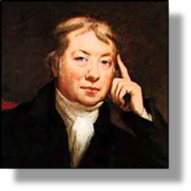 xxxxxThe English physician
Edward Jenner was born in Berkeley, Gloucestershire, the son of a
clergyman. Inx1770, after spending eight
years as a surgeon’s apprentice, he went to study at St. George’s
Hospital, London, working under John
Hunter (1728-1793), the distinguished
Scottish surgeon who did so much to advance medical education. From
him he learnt the vital importance of clinical observation, and the
need to experiment. He returned to Berkeley in 1773, and soon set up
a highly successful practice.
xxxxxThe English physician
Edward Jenner was born in Berkeley, Gloucestershire, the son of a
clergyman. Inx1770, after spending eight
years as a surgeon’s apprentice, he went to study at St. George’s
Hospital, London, working under John
Hunter (1728-1793), the distinguished
Scottish surgeon who did so much to advance medical education. From
him he learnt the vital importance of clinical observation, and the
need to experiment. He returned to Berkeley in 1773, and soon set up
a highly successful practice.
xxxxxIt was in 1788, during a
local epidemic of smallpox - a serious killer-disease in
those days - that he first noticed that milkmaids who had
contracted cowpox never went down with smallpox. In 1796
he performed his first experimental inoculation against smallpox (illustrated), and two 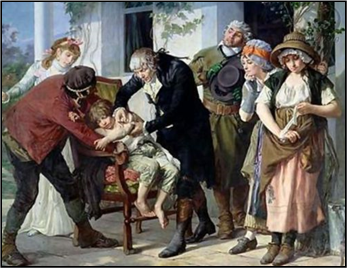 years
later published details of his treatment in his An
Inquiry into the Causes and Effects of the Variolae Vaccinae, A Disease Known by the Name of Cow Pox. In this paper he instanced the case,
among others, of an eight-year-old boy who, having been
inoculated with cowpox (a relatively harmless disease) had gained
immunity from smallpox by creating anti-bodies in his
bloodstream. He termed the treatment “vaccination” from the Latin
word for cowpox, vaccinia, and, after
some initial scepticism and practical difficulties, the procedure
came to be adopted throughout Europe and North America - there
widely employed by the efforts of the American physician Benjamin Waterhouse (1754-1846).
years
later published details of his treatment in his An
Inquiry into the Causes and Effects of the Variolae Vaccinae, A Disease Known by the Name of Cow Pox. In this paper he instanced the case,
among others, of an eight-year-old boy who, having been
inoculated with cowpox (a relatively harmless disease) had gained
immunity from smallpox by creating anti-bodies in his
bloodstream. He termed the treatment “vaccination” from the Latin
word for cowpox, vaccinia, and, after
some initial scepticism and practical difficulties, the procedure
came to be adopted throughout Europe and North America - there
widely employed by the efforts of the American physician Benjamin Waterhouse (1754-1846).
xxxxxHis
discovery was a breakthrough of immense value to medicine,
introducing an effective cure against the deadly smallpox, and
opening up the possibility of employing immunisation to combat a
range of other diseases - a branch of medical science which was
developed by the French chemist Louis Pasteur in the late 19th
century. In fact, however, though Jenner pioneered vaccination
clinically, the idea behind it had been known for some time. As
early as 1721, the English writer Lady Mary Wortley Montagu (1689-1762) - whose beauty had been marred by
smallpox when young - had spoken of seeing the value of this
treatment when living in Turkey as the wife of the British
ambassador. There, however, patients were inoculated with a mild
form of smallpox itself, and this clearly carried a risk of
introducing the disease rather than providing immunity against it.
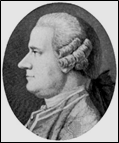
xxxxxThexDutch-born London physician and scientist Jan Ingenhousz (1730-1799),
best known for his discovery of the process of photosynthesis,
became an early proponent of this method at the city’s Foundling
Hospital. Known as “variolation” (because it used live virus taken
from patients suffering from a mild attack of the disease), in 1768
he was sent to Vienna by George III to inoculate the family members
of the Austrian empress Maria Theresa.
xxxxxJenner himself
made no money from his discovery. Indeed, he gave so much time to
promoting vaccination, providing it free for the London poor, that
his private practice suffered as a consequence. However, in 1804
Parliament granted him the sum of £10,000, and paid a further
£20,000 four years later. He retired from public life following the
death of his wife in 1815.
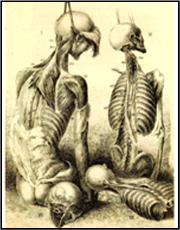
xxxxxIncidentally,
another outstanding physician at this time was the Scottish
anatomist John Bell
(1763-1820). In 1790 he opened his own school of anatomy in
Edinburgh, where he came to be regarded as the founder of surgical
anatomy. His works included Anatomy of the Human Body, published in 1793, and his
Discourse on the Nature and
Cure of Wounds, produced two years later. His Principles
of Surgery was completed in 1808. As we shall see, his
younger brother, Charles Bell, was also a physician. He treated the
wounded from the Battles of Corunna and Waterloo,
and became famous for the advancements he
made in neurology, the study of the nervous system.
Acknowledgements
Jenner: detail,
by the English painter James Northcote (1746-1831), 1803 –
National Portrait Gallery, London. Vaccination:
by the French artist Georges-Gaston Mélingue (1840-1914).
Ingenhousz: engraving, date and artist
unknown. Bichat: date and artist
unknown, contained in The History of Biology by the Finnish scientist Erik
Nordenskiold (1872-1933), 1928. Pinel:
by the French painter Charles Louis Lucien Muller (1815-1892)
– Académie Nationale de Médecine, Paris.
G3b-1783-1802-G3b-1783-1802-G3b-1783-1802-G3b-1783-1802-G3b-1783-1802-G3b
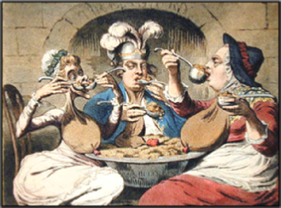 xxxxxTwo of his celebrated cartoons was The
Plum Pudding in Danger (illustrated
above), showing William Pitt and Napoleon
Bonaparte carving up the world, and a particularly cruel print
depicting the gluttony of George III, his wife, Queen Charlotte, and
their eldest son, the wayward Prince of Wales, feeding off John
Bull’s blood. Other well-known plates are The
Anti-Saccharites, Temperance
Enjoying a Frugal Meal, and King
George and his wife Frying Sprats and Toasting Muffins. His swift and powerful
denunciation of the French Revolution, following on The Terror and
the execution of Louis XVI, did much to sway public opinion against
such excesses. The sans-culottes
were depicted as depraved beasts, and he produced a series of prints
predicting the horrors which would befall the country if the French
managed to invade England and put an end to the British way of life.
xxxxxTwo of his celebrated cartoons was The
Plum Pudding in Danger (illustrated
above), showing William Pitt and Napoleon
Bonaparte carving up the world, and a particularly cruel print
depicting the gluttony of George III, his wife, Queen Charlotte, and
their eldest son, the wayward Prince of Wales, feeding off John
Bull’s blood. Other well-known plates are The
Anti-Saccharites, Temperance
Enjoying a Frugal Meal, and King
George and his wife Frying Sprats and Toasting Muffins. His swift and powerful
denunciation of the French Revolution, following on The Terror and
the execution of Louis XVI, did much to sway public opinion against
such excesses. The sans-culottes
were depicted as depraved beasts, and he produced a series of prints
predicting the horrors which would befall the country if the French
managed to invade England and put an end to the British way of life.
xxxxxAnother distinguished
physician in
Jenner’s time was the Frenchman Xavier
Bichat (1771-1802). He is generally
regarded as the founder of histology - the study of organic
tissue. He introduced the term “tissue” and identified 21 different
types in the human body. His findings were set out in two works
published in 1800, Treatise on Membranes
and Physiological Researches on Life and Death,
and in the two volumes of his General Anatomy,
produced in 1801.
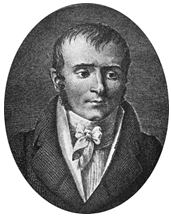 xxxxxAnother distinguished physician in Jenner’s time was the
Frenchman Xavier Bichat
(1771-1802). In 1800 he published his Traité
des membranes (Treatise on Membranes) in which he studied the structure of the
various organs of the body, and introduced the term “tissue”,
identifying 21 different types in the human body, and recognising
three of the four principal tissues - muscle, nerve and
connective. He also went on to record the post mortem changes made
in tissue by various diseases, publishing his findings in his Recherches physiologiques sur la vie et la mort
(Physiological Researches on Life and Death).
For his research in this field he became known as the founder of
histology - the study of organic tissue (from histos,
the Greek word for tissue). The first two volumes of his final work,
Anatomie Générale (General
Anatomy), were published in 1801.
xxxxxAnother distinguished physician in Jenner’s time was the
Frenchman Xavier Bichat
(1771-1802). In 1800 he published his Traité
des membranes (Treatise on Membranes) in which he studied the structure of the
various organs of the body, and introduced the term “tissue”,
identifying 21 different types in the human body, and recognising
three of the four principal tissues - muscle, nerve and
connective. He also went on to record the post mortem changes made
in tissue by various diseases, publishing his findings in his Recherches physiologiques sur la vie et la mort
(Physiological Researches on Life and Death).
For his research in this field he became known as the founder of
histology - the study of organic tissue (from histos,
the Greek word for tissue). The first two volumes of his final work,
Anatomie Générale (General
Anatomy), were published in 1801.
xxxxxHexwas
born at Thoirette in the French Jura and studied at Lyon before
going to Paris. There he assisted Pierre-Joseph
Desault (1744-1795) at the Hôtel-Dieu
hospital, and when this accomplished surgeon and anatomist died in
1795, he completed the final volume of his Journal
de chirurgie (Journal on Surgery).
Napoleon was impressed with the work of these two physicians, and
ordered that the busts of both men be placed in the Hotel-Dieu.
xxxxxIncidentally, It was around this time, in 1793, that another French
physician, Philippe Pinel
(1745-1825), was appointed head of the mental institute for men
at Bicètre, Paris. He revolted against the cruelty and neglect which
the inmates were suffering, and introduced a programme of reform,
banning chains and shackles, encouraging patients to discuss their
personal problems, and providing a programme of useful activities.
Two years later he did the same for the female asylum at Salpêtrière
in the city.
xxxxxThe idea of vaccination was
not without its critics. The English caricaturist James
Gillray (1757-1815), for example,
produced a savage cartoon in 1802 suggesting that those inoculated
would begin to act like cows. Gillray , an engraver by trade, was
influenced by the work of the artist William Hogarth, and turned his
hand to cartoons in the 1770s. His savage, biting attacks upon the
follies of the day earned him a wide reputation. At first his main
targets were politicians and the royal family but, with the outbreak
of the French Revolution, he turned his attack upon the French, and
Napoleon in particular. He produced over a thousand coloured
etchings, many noted for the exaggerated size of his victim’s
physical features.
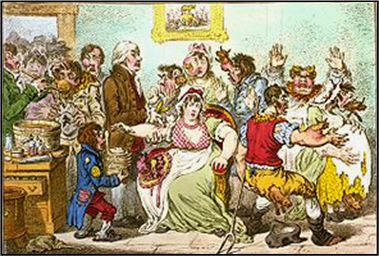 xxxxxBut, as noted, the idea of vaccination was
not without its critics. In 1802, for example, the brilliant English caricaturist James
Gillray (1757-1815)
produced a savage cartoon (illustrated) suggesting that those who had been inoculated
began to look and act like cows. Gillray began his working life as an
engraver, but in the mid-1770s, influenced by the works of
English artist William Hogarth, he began to use his coloured etchings
to launch fierce, often brutal attacks upon the follies of the day.
Unlike Hogarth, however, who was mainly a social commentator, Gillray
tended to focus his attention upon political affairs, though no one
could be sure of escaping his critical eye. Indeed, one of his
fiercest barbs was directed against Horatio Nelson’s mistress Lady
Hamilton, published under the title Dido in
Despair. His lampooning in general was characterised by a
gross exaggeration of the physical features of his “victims”, and this
outrageous, pitiless style set the tone for future political
cartooning.
xxxxxBut, as noted, the idea of vaccination was
not without its critics. In 1802, for example, the brilliant English caricaturist James
Gillray (1757-1815)
produced a savage cartoon (illustrated) suggesting that those who had been inoculated
began to look and act like cows. Gillray began his working life as an
engraver, but in the mid-1770s, influenced by the works of
English artist William Hogarth, he began to use his coloured etchings
to launch fierce, often brutal attacks upon the follies of the day.
Unlike Hogarth, however, who was mainly a social commentator, Gillray
tended to focus his attention upon political affairs, though no one
could be sure of escaping his critical eye. Indeed, one of his
fiercest barbs was directed against Horatio Nelson’s mistress Lady
Hamilton, published under the title Dido in
Despair. His lampooning in general was characterised by a
gross exaggeration of the physical features of his “victims”, and this
outrageous, pitiless style set the tone for future political
cartooning.
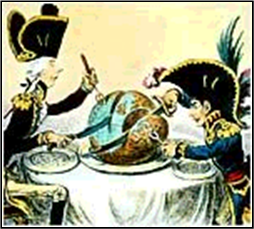 xxxxxAt first he directed much of his biting, witty satire
against leading politicians (such as Charles Fox, Edmund Burke and
William Pitt),
and against members of the royal family - particularly “Farmer
George” and his dissipated son the Prince of Wales. However, with
the coming of the French Revolution, he turned patriot, and his main
targets became the French in general and Napoleon in particular. He
produced over a thousand prints, the first authenticated one being Paddy on Horseback, published in 1779. His
publisher was a Miss Hanna Humphrey, and he lived in her house
throughout his career, displaying his work in the windows of her
printing shop. His colourful, audacious burlesques were well
received on the continent as well as at home, but the strain of the
work involved took their toll, and he was mentally deranged during
the last five years of his life.
xxxxxAt first he directed much of his biting, witty satire
against leading politicians (such as Charles Fox, Edmund Burke and
William Pitt),
and against members of the royal family - particularly “Farmer
George” and his dissipated son the Prince of Wales. However, with
the coming of the French Revolution, he turned patriot, and his main
targets became the French in general and Napoleon in particular. He
produced over a thousand prints, the first authenticated one being Paddy on Horseback, published in 1779. His
publisher was a Miss Hanna Humphrey, and he lived in her house
throughout his career, displaying his work in the windows of her
printing shop. His colourful, audacious burlesques were well
received on the continent as well as at home, but the strain of the
work involved took their toll, and he was mentally deranged during
the last five years of his life.
xxxxxHis “gallery”
included (left to right): George III, the Prince of Wales and his
mistress, Mrs Maria Fitzgerald, and the three politicians, Edmund
Burke, Richard Brinsley Sheridan, and Charles Fox.

xxxxx
Suchxprogressive ideas were introduced in
England in 1796 by the Quaker William
Tuke (1732-1822). He persuaded the
Society of Friends to open a Retreat in York, a home where the
mentally sick could receive “a milder and more appropriate system
of treatment”. Earlier, in 1788, a humanitarian regime of this
kind had been introduced by the Italian physician Vincenzo
Chiarugi (1759-1820) in his hospital
in Florence.
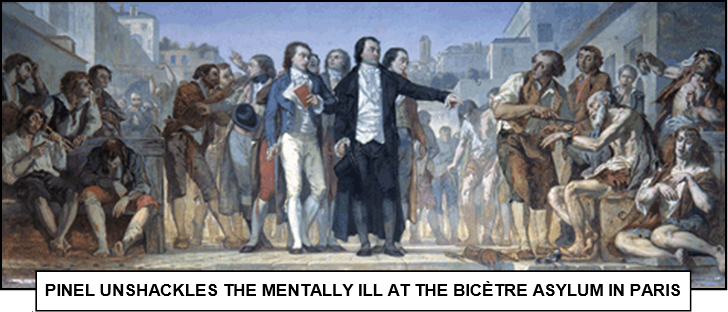







 xxxxxThe English physician
Edward Jenner was born in Berkeley, Gloucestershire, the son of a
clergyman. Inx1770, after spending eight
years as a surgeon’s apprentice, he went to study at St. George’s
Hospital, London, working under John
Hunter (1728-
xxxxxThe English physician
Edward Jenner was born in Berkeley, Gloucestershire, the son of a
clergyman. Inx1770, after spending eight
years as a surgeon’s apprentice, he went to study at St. George’s
Hospital, London, working under John
Hunter (1728- years
later published details of his treatment in his An
Inquiry into the Causes and Effects of the Variolae Vaccinae, A Disease Known by the Name of Cow Pox. In this paper he instanced the case,
among others, of an eight-
years
later published details of his treatment in his An
Inquiry into the Causes and Effects of the Variolae Vaccinae, A Disease Known by the Name of Cow Pox. In this paper he instanced the case,
among others, of an eight-

 xxxxxTwo of his celebrated cartoons was The
Plum Pudding in Danger (illustrated
above), showing William Pitt and Napoleon
Bonaparte carving up the world, and a particularly cruel print
depicting the gluttony of George III, his wife, Queen Charlotte, and
their eldest son, the wayward Prince of Wales, feeding off John
Bull’s blood. Other well-
xxxxxTwo of his celebrated cartoons was The
Plum Pudding in Danger (illustrated
above), showing William Pitt and Napoleon
Bonaparte carving up the world, and a particularly cruel print
depicting the gluttony of George III, his wife, Queen Charlotte, and
their eldest son, the wayward Prince of Wales, feeding off John
Bull’s blood. Other well- xxxxxAnother distinguished physician in Jenner’s time was the
Frenchman Xavier Bichat
(1771-
xxxxxAnother distinguished physician in Jenner’s time was the
Frenchman Xavier Bichat
(1771- xxxxxBut, as noted, the idea of vaccination was
not without its critics. In 1802, for example, the brilliant English caricaturist James
Gillray (1757-
xxxxxBut, as noted, the idea of vaccination was
not without its critics. In 1802, for example, the brilliant English caricaturist James
Gillray (1757- xxxxxAt first he directed much of his biting, witty satire
against leading politicians (such as Charles Fox, Edmund Burke and
William Pitt),
and against members of the royal family -
xxxxxAt first he directed much of his biting, witty satire
against leading politicians (such as Charles Fox, Edmund Burke and
William Pitt),
and against members of the royal family -



